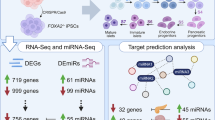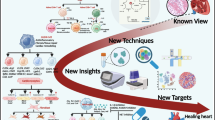Abstract
Background
MicroRNAs (miRNAs) can regulate expression of target genes at post transcriptional level, and mediate the pathophysiological process of many diseases.
Objective
The study will illuminate the miRNA expression profiles of diabetic cardiomyopathy (DCM), seeking probable biomarkers of DCM at early stage and determining a target for the treatment of DCM.
Methods
Db/db mice were used as an animal model of type 2 diabetes mellitus. At 22 weeks of age, cardiac function was evaluated by echocardiography, and the structural changes in myocardium were evaluated by HE staining and TEM. The miRNA expression profiles were detected using miRNA sequencing and differentially expressed miRNAs were validated by real-time PCR. Bioinformatic analysis was used to analyze target genes of these miRNAs and relevant pathways in DCM.
Results
The results showed that 40 miRNAs were differentially expressed, including 28 upregulated miRNAs and 12 downregulated miRNAs. GO and KEGG pathway analysis showed that the target genes of up-regulated miRNAs were involved in 66 pathways, including Wnt, p53 and calcium signaling pathways, as well as FOXO and apoptosis signaling pathways, etc. The target genes of down-regulated miRNAs were involved in 68 pathways, including mitophagy, Ras and MAPK signaling pathways, etc. Moreover, some differentially expressed miRNAs were found in myocardium of DCM for the first time, such as miR-7225-5p, miR-696, miR-3470a, miR-3470b, miR-6240, miR-6538, miR-5128, miR-1195, miR-203-3p and miR-330-5p.
Conclusions
It is hoped that a few novel molecular pathways or targets of treatment for DCM would be found through understanding the expression features of miRNAs in diabetic myocardium.



Similar content being viewed by others
References
Adams BD, Kasinski AL, Slack FJ (2014) Aberrant regulation and function of microRNAs in cancer. Curr Biol 24:R762–776
Bai J, Liu C, Zhu P, Li Y (2020) Novel insights into molecular mechanism of Mitochondria in Diabetic Cardiomyopathy. Front Physiol 11:609157
Bartel DP (2004) MicroRNAs: genomics, biogenesis, mechanism, and function. Cell 116:281–297
Boudina S, Abel ED (2010) Diabetic cardiomyopathy, causes and effects. Rev Endocr Metab Disord 11:31–39
Bugger H, Boudina S, Hu XX, Tuinei J, Zaha VG, Theobald HA, Yun UJ, McQueen AP, Wayment B, Litwin SE et al (2008) Type 1 diabetic akita mouse hearts are insulin sensitive but manifest structurally abnormal mitochondria that remain coupled despite increased uncoupling protein 3. Diabetes 57:2924–2932
Che H, Wang Y, Li Y, Lv J, Li H, Liu Y, Dong R, Sun Y, Xu X, Zhao J et al (2020) Inhibition of microRNA-150-5p alleviates cardiac inflammation and fibrosis via targeting Smad7 in high glucose-treated cardiac fibroblasts. J Cell Physiol 235:7769–7779
Chen D, Zhang M (2021) GAS5 regulates diabetic cardiomyopathy via miR2213p/p27 axisassociated autophagy. Mol Med Rep 23
Chistiakov DA, Orekhov AN, Bobryshev YV (2017) The impact of FOXO-1 to cardiac pathology in diabetes mellitus and diabetes-related metabolic abnormalities. Int J Cardiol 245:236–244
Colpaert RMW, Calore M (2019) MicroRNAs in Cardiac Diseases. Cells 8
Copier CU, Leon L, Fernandez M, Contador D, Calligaris SD (2017) Circulating miR-19b and miR-181b are potential biomarkers for diabetic cardiomyopathy. Sci Rep 7:13514
Diao X, Shen E, Wang X, Hu B (2011) Differentially expressed microRNAs and their target genes in the hearts of streptozotocin-induced diabetic mice. Mol Med Rep 4:633–640
Dillmann WH (2019) Diabetic Cardiomyopathy. Circ Res 124:1160–1162
Ding H, Yao J, **e H, Wang C, Chen J, Wei K, Ji Y, Liu L (2021) MicroRNA-195-5p downregulation inhibits endothelial mesenchymal transition and myocardial fibrosis in Diabetic Cardiomyopathy by Targeting Smad7 and inhibiting transforming growth factor Beta 1-Smads-snail pathway. Front Physiol 12:709123
Evangelista I, Nuti R, Picchioni T, Dotta F, Palazzuoli A (2019) Molecular dysfunction and phenotypic derangement in Diabetic Cardiomyopathy. Int J Mol Sci 20
Fu F, Liu C, Shi R, Li M, Zhang M, Du Y, Wang Q, Li J, Wang G, Pei J et al (2021) Punicalagin protects against Diabetic Cardiomyopathy by promoting Opa1-Mediated mitochondrial Fusion via regulating PTP1B-Stat3 pathway. Antioxid Redox Signal 35:618–641
Gao L, Liu Y, Guo S, **ao L, Wu L, Wang Z, Liang C, Yao R, Zhang Y (2018) LAZ3 protects cardiac remodeling in diabetic cardiomyopathy via regulating miR-21/PPARa signaling. Biochim Biophys Acta Mol Basis Dis 1864:3322–3338
Gu J, Wang S, Guo H, Tan Y, Liang Y, Feng A, Liu Q, Damodaran C, Zhang Z, Keller BB et al (2018) Inhibition of p53 prevents diabetic cardiomyopathy by preventing early-stage apoptosis and cell senescence, reduced glycolysis, and impaired angiogenesis. Cell Death Dis 9:82
Hong CS, Kwon SJ, Cho MC, Kwak YG, Ha KC, Hong B, Li H, Chae SW, Chai OH, Song CH et al (2008) Overexpression of junctate induces cardiac hypertrophy and arrhythmia via altered calcium handling. J Mol Cell Cardiol 44:672–682
Hu L, Ding M, Tang D, Gao E, Li C, Wang K, Qi B, Qiu J, Zhao H, Chang P et al (2019) Targeting mitochondrial dynamics by regulating Mfn2 for therapeutic intervention in diabetic cardiomyopathy. Theranostics 9:3687–3706
Hummel KP, Dickie MM, Coleman DL (1966) Diabetes, a new mutation in the mouse. Science 153:1127–1128
Jakubik D, Fitas A, Eyileten C, Jarosz-Popek J, Nowak A, Czajka P, Wicik Z, Sourij H, Siller-Matula JM, De Rosa S et al (2021) MicroRNAs and long non-coding RNAs in the pathophysiological processes of diabetic cardiomyopathy: emerging biomarkers and potential therapeutics. Cardiovasc Diabetol 20:55
Jankauskas SS, Gambardella J, Sardu C, Lombardi A, Santulli G (2021) Functional role of miR-155 in the Pathogenesis of Diabetes Mellitus and its complications. Noncoding RNA 7
Jeyabal P, Thandavarayan RA, Joladarashi D, Suresh Babu S, Krishnamurthy S, Bhimaraj A, Youker KA, Kishore R, Krishnamurthy P (2016) MicroRNA-9 inhibits hyperglycemia-induced pyroptosis in human ventricular cardiomyocytes by targeting ELAVL1. Biochem Biophys Res Commun 471:423–429
Jia G, Whaley-Connell A, Sowers JR (2018) Diabetic cardiomyopathy: a hyperglycaemia- and insulin-resistance-induced heart disease. Diabetologia 61:21–28
Khakdan S, Delfan M, Heydarpour Meymeh M, Kazerouni F, Ghaedi H, Shanaki M, Kalaki-Jouybari F, Gorgani-Firuzjaee S, Rahimipour A (2020) High-intensity interval training (HIIT) effectively enhances heart function via miR-195 dependent cardiomyopathy reduction in high-fat high-fructose diet-induced diabetic rats. Arch Physiol Biochem 126:250–257
Lecarpentier Y, Claes V, Duthoit G, Hebert JL (2014) Circadian rhythms, Wnt/beta-catenin pathway and PPAR alpha/gamma profiles in diseases with primary or secondary cardiac dysfunction. Front Physiol 5:429
Maack C, Lehrke M, Backs J, Heinzel FR, Hulot JS, Marx N, Paulus WJ, Rossignol P, Taegtmeyer H, Bauersachs J et al (2018) Heart failure and diabetes: metabolic alterations and therapeutic interventions: a state-of-the-art review from the Translational Research Committee of the heart failure Association-European Society of Cardiology. Eur Heart J 39:4243–4254
Mathur P, Rani V (2021) MicroRNAs: a critical Regulator and a Promising Therapeutic and Diagnostic Molecule for Diabetic Cardiomyopathy. Curr Gene Ther 21:313–326
Mittal A, Garg R, Bahl A, Khullar M (2021) Molecular Mechanisms and Epigenetic Regulation in Diabetic Cardiomyopathy. Front Cardiovasc Med 8:725532
Montaigne D, Marechal X, Coisne A, Debry N, Modine T, Fayad G, Potelle C, El Arid JM, Mouton S, Sebti Y et al (2014) Myocardial contractile dysfunction is associated with impaired mitochondrial function and dynamics in type 2 diabetic but not in obese patients. Circulation 130:554–564
Ortega FJ, Mercader JM, Moreno-Navarrete JM, Rovira O, Guerra E, Esteve E, **fra G, Martinez C, Ricart W, Rieusset J et al (2014) Profiling of circulating microRNAs reveals common microRNAs linked to type 2 diabetes that change with insulin sensitization. Diabetes Care 37:1375–1383
Prattichizzo F, Giuliani A, De Nigris V, Pujadas G, Ceka A, La Sala L, Genovese S, Testa R, Procopio AD, Olivieri F et al (2016) Extracellular microRNAs and endothelial hyperglycaemic memory: a therapeutic opportunity? Diabetes Obes Metab 18:855–867
Raut SK, Singh GB, Rastogi B, Saikia UN, Mittal A, Dogra N, Singh S, Prasad R, Khullar M (2016) miR-30c and miR-181a synergistically modulate p53-p21 pathway in diabetes induced cardiac hypertrophy. Mol Cell Biochem 417:191–203
Ruiz-Ortega M, Rayego-Mateos S, Lamas S, Ortiz A, Rodrigues-Diez RR (2020) Targeting the progression of chronic kidney disease. Nat Rev Nephrol 16:269–288
Tao L, Huang X, Xu M, Yang L, Hua F (2020) MiR-144 protects the heart from hyperglycemia-induced injury by regulating mitochondrial biogenesis and cardiomyocyte apoptosis. FASEB J 34:2173–2197
Yang X, Li X, Lin Q, Xu Q (2019) Up-regulation of microRNA-203 inhibits myocardial fibrosis and oxidative stress in mice with diabetic cardiomyopathy through the inhibition of PI3K/Akt signaling pathway via PIK3CA. Gene 715:143995
Yildirim SS, Akman D, Catalucci D, Turan B (2013) Relationship between downregulation of miRNAs and increase of oxidative stress in the development of diabetic cardiac dysfunction: junctin as a target protein of miR-1. Cell Biochem Biophys 67:1397–1408
Yin Z, Zhao Y, He M, Li H, Fan J, Nie X, Yan M, Chen C, Wang DW (2019) MiR-30c/PGC-1beta protects against diabetic cardiomyopathy via PPARalpha. Cardiovasc Diabetol 18:7
Yu M, Liu Y, Zhang B, Shi Y, Cui L, Zhao X (2015) Inhibiting microRNA-144 abates oxidative stress and reduces apoptosis in hearts of streptozotocin-induced diabetic mice. Cardiovasc Pathol 24:375–381
Zhang WY, Wang J, Li AZ (2020) A study of the effects of SGLT-2 inhibitors on diabetic cardiomyopathy through miR-30d/KLF9/VEGFA pathway. Eur Rev Med Pharmacol Sci 24:6346–6359
Zhang M, Sui W, **ng Y, Cheng J, Cheng C, Xue F, Zhang J, Wang X, Zhang C, Hao P et al (2021) Angiotensin IV attenuates diabetic cardiomyopathy via suppressing FoxO1-induced excessive autophagy, apoptosis and fibrosis. Theranostics 11:8624–8639
Zhao L, Li W, Zhao H (2020) Inhibition of long non-coding RNA TUG1 protects against diabetic cardiomyopathy induced diastolic dysfunction by regulating miR-499-5p. Am J Transl Res 12:718–730
Zhou H, Li YJ, Wang M, Zhang LH, Guo BY, Zhao ZS, Meng FL, Deng YG, Wang RY (2011) Involvement of RhoA/ROCK in myocardial fibrosis in a rat model of type 2 diabetes. Acta Pharmacol Sin 32:999–1008
Zhou H, Sun Y, Zhang L, Kang W, Li N, Li Y (2018) The RhoA/ROCK pathway mediates high glucose-induced cardiomyocyte apoptosis via oxidative stress, JNK, and p38MAPK pathways. Diabetes Metab Res Rev 34:e3022
Acknowledgements
This research was supported by Nature Foundation of Hebei Province (No. H2019206196) and Medical Science Research Project of Hebei Province (No. 20210371), Hebei, China. The authors thank Professors Rong Zhang (Department of toxicology, Hebei Medical University, Shijiazhuang, China) and Kangchen Biotech Co., Ltd. (Shanghai, China) for technological assistance with the experiments.
Author information
Authors and Affiliations
Corresponding author
Ethics declarations
Conflicts of interest
None of the authors have any potential conflicts of interest associated with this research.
Additional information
Publisher’s Note
Springer Nature remains neutral with regard to jurisdictional claims in published maps and institutional affiliations.
Electronic supplementary material
Below is the link to the electronic supplementary material.
Rights and permissions
Springer Nature or its licensor (e.g. a society or other partner) holds exclusive rights to this article under a publishing agreement with the author(s) or other rightsholder(s); author self-archiving of the accepted manuscript version of this article is solely governed by the terms of such publishing agreement and applicable law.
About this article
Cite this article
Wang, T., Yuan, L., Chen, Y. et al. Expression profiles and bioinformatic analysis of microRNAs in myocardium of diabetic cardiomyopathy mice. Genes Genom 45, 1003–1011 (2023). https://doi.org/10.1007/s13258-023-01403-8
Received:
Accepted:
Published:
Issue Date:
DOI: https://doi.org/10.1007/s13258-023-01403-8




